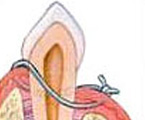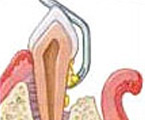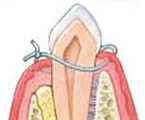The most common periodontal surgery options are pocket reduction procedures and regenerative procedures. Both may be advised when root planing and scaling do not help in the restoration process.
Pocket Reduction Procedures
This involves the folding back of gum tissue, in addition to the removal of disease-causing plaque and tartar. Irregular surfaces of the damaged bone may be smoothened to allow the gum tissue to better reattach to healthy bone. Sutures are then used to secure the gum tissue at its new position.
Eliminating bacteria alone may not be sufficient to prevent recurrence of periodontal disease. Since deeper pockets are more difficult for you and your dentist to clean, it’s important to reduce them. Combining this proper oral hygiene and regular cleanings will increase the chances of keeping your natural teeth.
Bone Graft and Guided Tissue Regeneration
If a defect exists in the bone, a bone graft may be placed to stimulate new bone formation. Natural or synthetic bone can be used for regeneration. At times, specialized membranes can be an option to prevent the gum tissue from creeping in between the tooth and bone. This then creates a regeneration of new bone and periodontal ligament.
Cosmetic Surgical Procedures
Crown Lengthening
Crown lengthening involves the removal of gum tissue; bone or both expose a tooth’s structure more sufficiently.
The procedure is done when a tooth breaks off at the gum line, or a filling or crown falls out of a tooth with extensive decay underneath. Your dentist may need to expose more of the tooth by removing some tissue and bone.
Occasionally, where an unusually large amount of gum tissue shows around the upper teeth (called a gummy smile), crown lengthening may be used.
Procedure
Done under local anesthesia, incisions are made to reflect the gums away from the teeth. Doing this provides access to the roots of the teeth and surrounding bone. In most situations, your periodontist will need to remove some bone from around the roots of the teeth. By using a combination of rotary and hand instruments, the bone is removed and the gum tissue is secured with sutures.
Since the gums are now sitting at a lower level than before the surgery, your teeth will look longer and more attractive. Sometimes, an intraoral bandage will be used to cover the site and help protect it during healing. We will remove any temporary crowns prior to the procedure and replace them afterward.
Soft Tissue Grafts
Soft tissue grafts help treat gum recession and can improve the esthetics of one’s gum line. Aggressive tooth brushing, periodontal disease or clenching of teeth can all play a role in gum recession. Exposed tooth roots, the byproduct of gum recession, gives you an older look and causes sensitivity to cold liquids and foods.
Soft tissue grafts can cover roots or develop gum tissue where needed. To complete this procedure, your periodontist takes gum tissue from your palate or another donor source to cover the root. Not only can a soft tissue graft further reduce recession and bone loss, but also protect the root from decay and heightened sensitivity.






